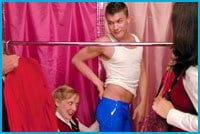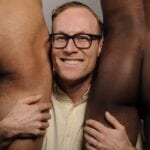They are fat and witty, wear makeup and jewellery to clownish excess and bitterly drown their inability to have functional relationships in booze and self-loathing. Or they’re the ladies who love to have you in tow on shopping trips and for nights out clubbing and find it endearing that you cry during movies. If these scenes come to mind on hearing the words “fag hag,” Justine Pimlott and Maya Gallus’s new documentary proves that relationships between straight women and gay men can be much deeper and more complex.
Fag Hags: Women Who Love Gay Men is focussed on three couples, one physical and two platonic relationships filled with more emotional involvement, dedication and intimacy than many couples who actually have compatible sexual orientations.
“I really wanted to go beyond the clichés and stereotypes and get into the complexities and universality of the stories,” says director Pimlott. “I think ultimately the film is about love.”
The relationships are intense: Kevin and Dodie (who are married – he gave up his gay identity for her amid the early years of the AIDS crisis); Matt and Cynthia (very close friends who have weathered 30 years of ups and downs in their relationship) and the younger Denis and Dana (he thought they might be able to be romantically involved but she didn’t – now they are planning a family together). If they seem to stretch the limits of the term fag hag, try to think of a better phrase…. There isn’t one.
The fag hag figure is the historical context for straight women who find the most emotional, psychological and social satisfaction – and political solidarity – with gay men. “I’m saying ‘fag hags’ because we don’t have anything else and I’m trying to look at what ‘fag hag’ means to us and then go beyond it. Some women identify with it and some don’t. I’d like to come up with a new name that challenges it but for now that’s what we have, so how do we deconstruct it?”
Pimlott wants fag hags to feel welcome under the queer umbrella. “These are queer stories and this is a queer film. These women don’t fit into the mainstream heterosexual culture because of their bonds with the gay men in their lives and they feel an acceptance of who they are that they don’t feel with straight men. Historically, they were ridiculed or pitied.”
Pimlott and Gallus, the film’s producer and cowriter, flesh out this history with documentary vignettes and clips of such tragic hags as Catherine (Liz Taylor) in the 1959 film version of Tennessee Williams’s Suddenly Last Summer, a piece of unwitting man-bait for her lustful gay cousin Sebastian who is almost punished for her transgressions with a lobotomy. “‘Fag hag’ has always been a derogatory term,” Pimlott claims. “It’s just now that it’s being reclaimed.”
Pimlott and Gallus include self-proclaimed “queen hag” Sue from the New York-based group SWISH (Straight Women In Support Of Homos) and queer comic Margaret Cho (“I love the word faggot because it describes my kind of guy”) as examples of this new generation, an activist movement reappropriating the term. “They felt like they weren’t just going to go shopping and have brunch with their gay male friends. They had a political analysis and wanted to fight against homophobia. It comes full-circle from Cynthia, for example, marching against the bathhouse raids in the early ’80s.” This involvement is nothing new. “Straight women have always been part of the gay community. Most gay men have a woman in their life who they have a profound relationship or connection with on many levels. Everyone has a fag-hag story.”
The doc’s premiere at Inside Out is only fitting for Pimlott, whose acclaimed feature Laugh In The Dark won best Canadian film in 2000. The festival also provided the venue for the film’s inspiration: a special fundraiser screening of Queer As Folk packed with ecstatic straight female fans going wild for their beloved homo characters.
Pimlott and Gallus are also responding to the increased marketing of fags as the latest accessory: “Gay men are the new hot commodity through Queer Eye For The Straight Guy. It’s kind of bizarre, that’s why I wanted to show the depth. It’s much more than that and it’s much more complicated than that. We wanted to challenge frivolous representations of the relationship that we have from mainstream culture.
“There is an intimacy, an alliance, that goes beyond consumerism.”


 Why you can trust Xtra
Why you can trust Xtra


